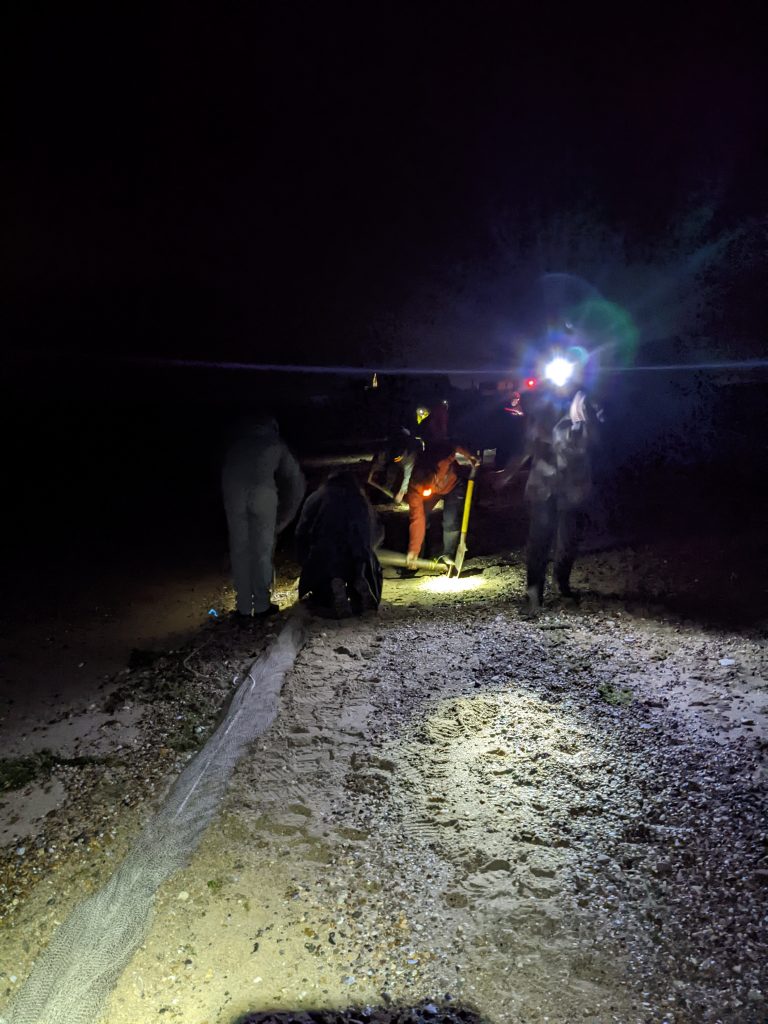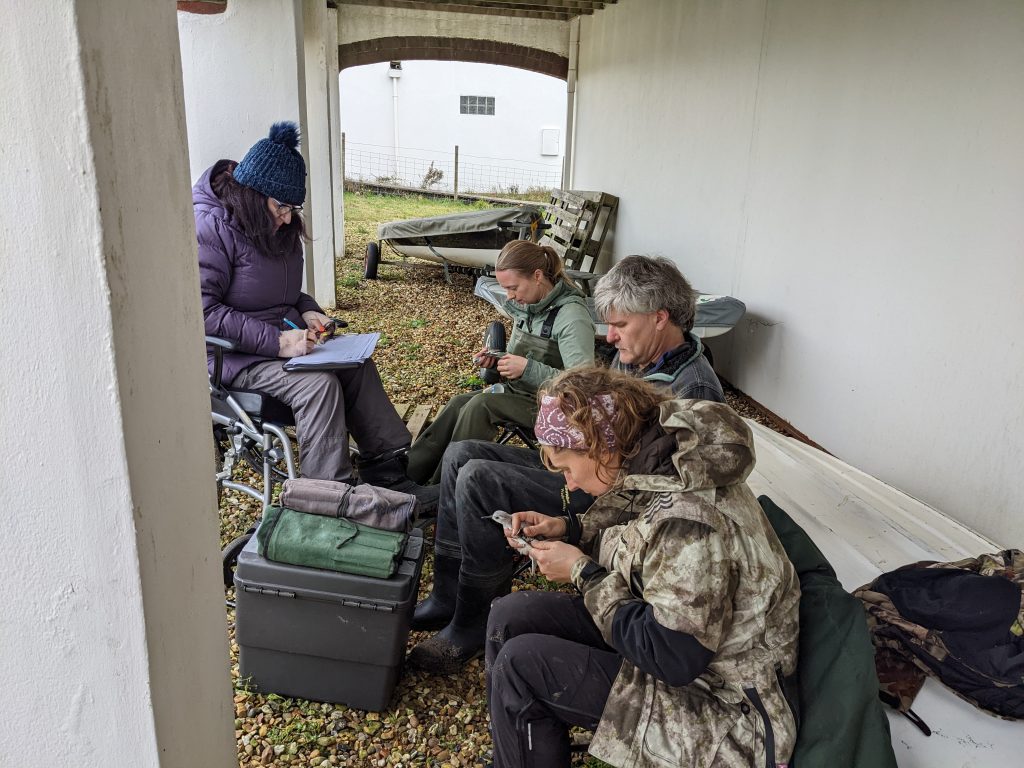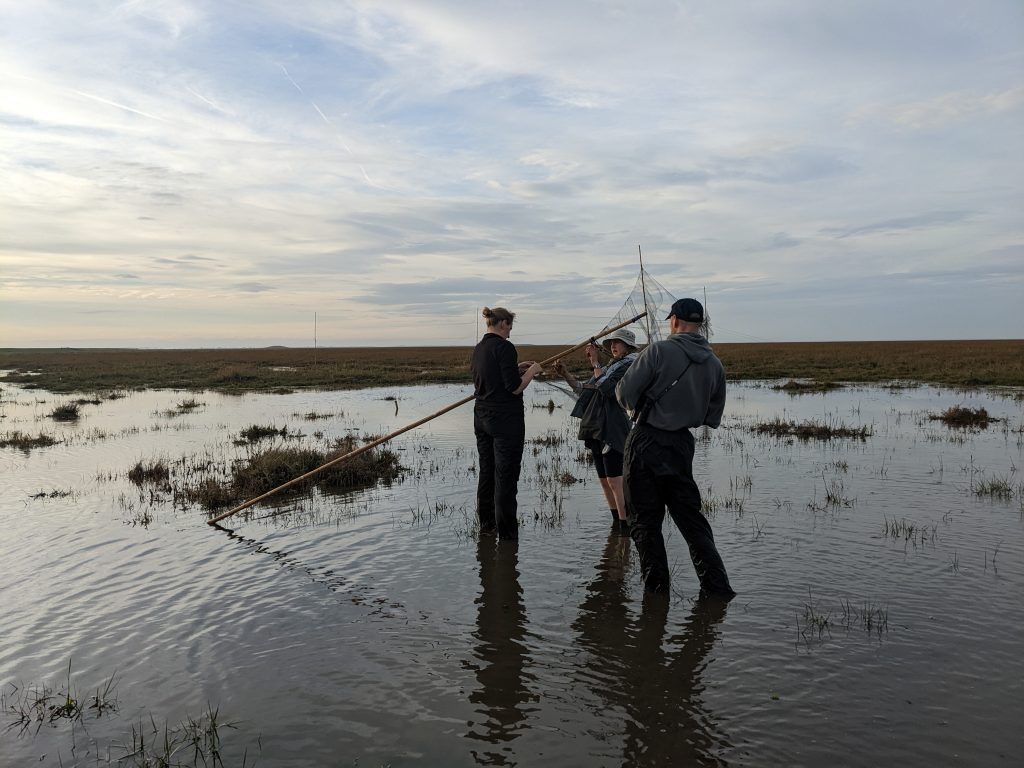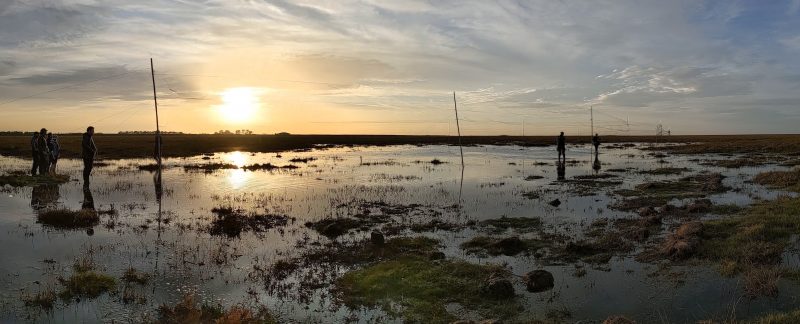Tim, Selena and Dave arrived at the Norfolk base earlier in the week to work on house and garden maintenance. In particular they removed a large amount of the excess vegetation that had grown up in the garden and Dave in particular helped wire up the potential decoy store. Cathy joined them for some of the time and Mark also helped out but wasn’t able to stay on for the weekend. This team put in a significant amount of effort over these few days and so deserve a big thank you from the group!
Friday 28 October
Tim did a recce in the morning and found:
Snettisham North North – 250 Sanderling, 50 Knot at 07:15–07:45;
Heacham North North – 250 Sanderling in 2 groups, 50 Knot at 07:55–08:10;
Heacham South – 30 Curlew, 50 Oystercatcher, lots of Greylag Geese;
Ken Hill & Sandringham fields – no Curlew seen.
Everyone assembled through the late afternoon and evening at the base house and enjoyed a very tasty dinner of fajitas made by Tim and Selena. After dinner, people split to wash up and also pack the trailer before Ros and Guy held a team meeting to discuss the plans for the weekend. The plans were to set a small mesh net at Heacham North North in the morning to catch the Sandlering that had been seen the day before by Tim on the recce. The process for working with small-mesh nets was demonstrated and everyone was assigned to cars ready for the morning. Lizzie and Ryan arrived with Flo a little later, and full introductions were carried out, before Guy did the final house briefing.
Saturday 29 October
The setting team got up at 04:30 to leave at 05:00 for Heacham N.N. whilst the rest of the team got up at 05:45 to follow along a little later. Two small-mesh nets were set in a line and the team settled in to wait for the birds to come in.

After some excellent twinkling by Molly the nets were fired at 07:50 and 41 Sanderling plus two Ringed Plovers were caught. This was Lizzie’s second catch as a new licence holder (well done Lizzie!). Given that the Sanderling were still keen on being on this beach, and that most of the flock were still moving around, we reset a net for the falling tide a little further south on the beach while the rest of the team started ringing and processing the first catch. Due to the height of the tide, the other unfired net couldn’t be left out – Nigel later told the trip leaders… ‘ah yeah we normally set further south’…that’s experience for you! All the birds from the first catch were kept to prevent them being potentially recaught on the falling tide.
With some excellent twinkling (including about 40 m of crawling) again from Guy, Dave and Bob, the second net was fired by Ros at 09:57 with 55 more Sanderling caught alongside two Turnstone and four Ringed Plover. The lift went very well and all birds were soon extracted. Michelle had a great view from near the top of the sea wall and took a video of the fire and ‘tenting’. The first catch was released, now it was clear to do so, and the second ringed and processed. Whilst the final birds were being processed (including the Turnstone being colour-ringed) some of the team headed back to base to start breakfast.

Heacham North North (fire 1)
| Species | New | Retrap | Total |
| Ringed Plover | 1 | 1 | 2 |
| Sanderling | 35 | 6 | 41 |
| Black-headed Gull | 1 | 0 | 1 |
| Totals | 37 | 7 | 44 |
Heacham North North (fire 2)
| Species | New | Retrap | Total |
| Ringed Plover | 2 | 2 | 4 |
| Sanderling | 53 | 2 | 55 |
| Turnstone | 2 | 0 | 2 |
| Totals | 57 | 4 | 61 |
After everyone was back at base and had enjoyed a hearty breakfast, the team leads held the catch debrief. They explained that between the two catches we’d caught most of what we were expecting to be on the beach and thanked the team for splitting up so well between different tasks given the impromptu reset. The twinkling had had to start quite a way down the beach moving around 250 birds up towards the nets, but during the last flush 150 birds didn’t come back. There was quite an age difference between the two catches with mostly juveniles caught in the second catch and birds still wanted to be further south on the widest part of the beach.
The evening’s plans were to mist net at the Terrington Pools and given Rob P reported that there weren’t any significant numbers at Snettisham, it was decided that there wouldn’t be a second morning’s cannon-netting on the Sunday but that the team would set themselves up to go out resighting. There were lots of other jobs that could be usefully carried out at the base before the evening’s mist-netting – a setting team went down to the marsh at 15:30 whilst the others finished off the other jobs. Cathy and Katharine cooked a curry during this time and Nick put together a crumble for pudding (thanks to Molly as well for helping when extra hands were needed!). The setting team were back at 18:00 and everyone ate ready to leave for the marsh at 18:45.

At the marsh, the team was split between the two sets of nets over the White Barn Pools and the newer pools a bit further out (later referred to as ‘Tim’s Trudge’). A big thanks to Cathy and Michele for setting up basecamp. The nets immediately started catching well with the far nets catching a large godwit flock to start followed by Oystercatchers, Dunlin, Redshank and many more birds! Nicholas, Flo and Claudia were quickly sent back with the birds and asked to return with more sacks. Lizzie and Molly went back to base from the White Barn Pools to get started on processing the godwits. At the far nets the decision to switch off the sound lure, then to put head torches on, was soon taken to reduce the numbers of birds coming in. The remaining catch was sent back with the team to base as Rob P and Ryan stayed to close the nets. Guy and Tim stayed to take down the White Barn nets then headed in themselves. Two processing teams were soon on the go with a colour-ringing team in the middle and, barring a short break for a snack, it was all go until the last birds were ringed and released. The team made it back to the base house for 01:00, in time for a few celebratory drinks and relaxing to watch the extra hour arrive at 02:00 (01:00 with the clock change) and the last people soon headed to bed.
White Barn Pools (mist-netting – both sets of pools)
| Species | New | Retrap | Total |
| Bar-tailed godwit | 3 | 1 | 4 |
| Black-tailed godwit | 59 | 2 | 61 |
| Dunlin | 122 | 1 | 123 |
| Grey Plover | 7 | 1 | 8 |
| Knot | 40 | 1 | 41 |
| Oystercatcher | 40 | 0 | 40 |
| Redshank | 36 | 0 | 36 |
| Turnstone | 6 | 0 | 6 |
| Totals | 313 | 6 | 319 |
Sunday 30 October
Those who were heading out to resight (at six locations) were up around 08:00 to leave at 08:30 (although Molly and Lizzie left earlier than this to get to Freiston). Four teams started with fields likely to have Curlew in before moving to general resighting locations whilst the other two teams focused on good resighting locations only. Ros, Ryan and Tim stayed back at the base house to tidy up at the outer pool from last night plus getting started with disinfecting the kit and sorting the data. Everyone was back at 13:30 to eat (many thanks to Ros, Ryan and others for the baked potatoes!). For those who were able to stay a little longer there was a debrief of the resightings plus a useful discussion on how the weekend had gone and if there was any room for improvements. In the afternoon people started to clean and pack up before final goodbyes were said and the team headed off to their respective homes.
Resighting reports by team:
Snettisham (sea wall) – Rob R, Daniel & Justin. Found very little in this area, Justin walked up Snettisham sea wall and saw some Lapwing in flight plus a Grey Partridge, Rob and Daniel made their first stop to the beach before looking into the field behind Carole & Bernard’s place where they found 40–50 Curlew (~11:00–11:30) but weren’t able to read any of the four flagged birds in the field (one of which was also had a GPS/GSM tag).
Freiston – Molly & Lizzie. They didn’t find much and, although the muddy strip in the main pool was covered, they didn’t think the tide was high enough for more birds to be pushed over into the site. The field with rough grass a little further on had 30 Curlew but no flags were seen.
Snettisham Beach – Guy, Chantal & Flo. Heading along Beach Road they saw Curlew only in the first left field but this included six flags read (19 Curlew in total). There were no others in any other field heading towards the beach and also the RSPB car park field had no Curlew. They walked to the beach in time for the falling tide and found ~100 Bar-tailed Godwit with some flags, but no Grey Plover. There were lots of Knot (~500–700), but they were too far away to read, and very few Curlew.
Heacham North & Ken Hill fields – Rob P, Katharine & Claudia. Starting off at the Ken Hill Teapot field cluster on the A149 they found 56 Curlew in a nearby field where they have been spotted before (east side of the main road) and read eight flags. No other inland locations nearby had Curlew and so they continued to Heacham North North where they read six Turnstone combinations on the falling tide. Before they left they found a flock of 49+ Curlew (three hours after high tide) and Rob was able to read 12 Curlew (including a headstarted bird 4L) and six Bar-tailed Godwits.
Inland – Cathay & Ed. They travelled around 70 miles of Norfolk fields finding a number of birds in fields but only being able to read three clearly. They did find a flock of 50 Curlew in a stubble field with eight or nine flags but again they couldn’t read these clearly.
Trip Ringing Totals
| Species | New | Retrap | Total |
| Bar-tailed godwit | 4 | 1 | 5 |
| Black-tailed godwit | 58 | 2 | 60 |
| Dunlin | 122 | 1 | 123 |
| Grey Plover | 7 | 1 | 8 |
| Knot | 40 | 1 | 41 |
| Oystercatcher | 40 | 0 | 40 |
| Redshank | 36 | 0 | 36 |
| Ringed Plover | 3 | 3 | 6 |
| Sanderling | 88 | 8 | 96 |
| Turnstone | 8 | 0 | 8 |
| Totals | 408 | 17 | 425 |
Resightings
| Species | Sightings | Individuals | WWRG | Non-WWRG |
| Curlew | 30 | 29 | 29 | 0 |
| Bar-tailed godwit | 8 | 8 | 8 | 0 |
| Turnstone | 6 | 6 | 6 | 0 |
| Totals | 43 | 42 | 42 | 0 |
Thanks to Katharine Bowgen for writing this report.

